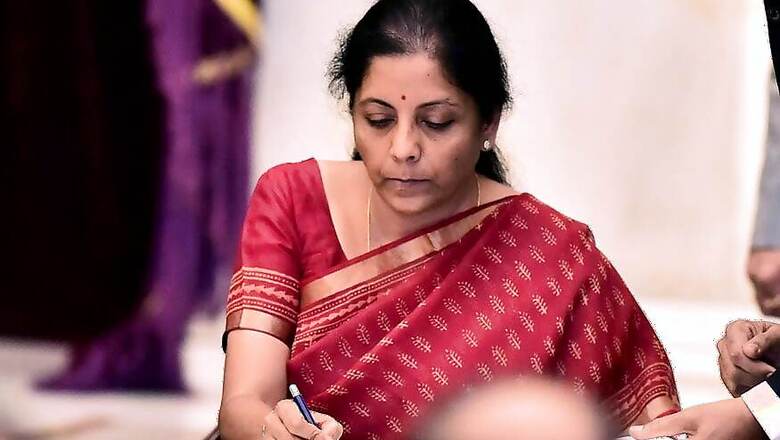
views
The Economic Survey ticks all the right boxes in exhorting industry to come forward with investments to boost growth, debunking the correlation between increasing investments and job destruction, and explaining why the small and medium enterprises are erroneously thought to be mega job creators etc.
The overriding theme of the survey this time is job creation, as it should be. It also forecasts that the Indian economy will grow at 7% this fiscal, which would be an improvement over the 6.8% growth rate clocked in 2018-19.
But if the government expects increased capex (capital expenditure) from India Inc., the onus is on it to announce measures to encourage such private capex. Will the finance minister oblige with a fiscal stimulus package in her Budget speech on Friday to encourage private investment? A monetary stimulus has already been provided by the RBI through three successive and unprecedented rate cuts.
Why increased private investments hold the key to economic revival is obvious. According to analysts at Fitch group company India Ratings, the current investment cycle is heavily dependent on government capex spending but the government alone will not be able to do “the heavy lifting because the share of government (central and state) in total capex of the economy was just 12.0% during FY12-FY18”.
And to encourage companies to invest more, the government will have to offer some incentives. In its pre-Budget memorandum, the Federation of Indian Chambers of Commerce and Industry (FICCI) had specifically sought a fiscal stimulus precisely to spur private investments. The chamber sought reduction in the corporate tax rate, creation of special industrial zones to promote manufacturing and exports, and enhanced government investments in specific sectors such as power, infrastructure, oil and gas etc.
While making repeated mention of how important increased private investment is to kick-start the economy, the survey says “This survey makes the case for investment as the ‘key driver’ that can create a self-sustaining virtuous cycle in India. This investment can be both government investments in infrastructure, as such investment crowds in private investment (Chakrabarti, Subramanian and Sesha, 2017), and private investment in itself.”
The survey cites several reasons to say that the decline in investments has bottomed out, including political stability. And goes on to say that higher capacity utilisation and uptick in business expectations should increase investment activity in 2019-20.
“Accommodative monetary policy in the beginning of the year should help in decreasing real lending rates, more so, if the transmission mechanism improves. There are signs of continuing resolution of stressed assets in the banking sector as reflected in decline in NPA to gross advances ratio as on December 2018, which should push the capex cycle.”
Growth in investment, which had slowed down for many years, has bottomed out and has started to recover since 2017-18. Growth in fixed investment picked up from 8.3% in 2016-17 to 9.3% in 2017-18 and further to 10% in 2018-19.
Elsewhere, the survey notes that the government withheld some revenue expenditure in 2018-19 to contain fiscal deficit but actually increased capex. As per cent of GDP, total expenditure fell by 0.3 percentage points in 2018-19 over 2017-18, with 0.4 percentage points reduction in revenue expenditure and 0.1 percentage point increase in capital expenditure. Over 2017-18, total expenditure has grown by 7.9 per cent in 2018-19, with its capital component growing at more than twice the rate of growth in revenue.
The survey also notes that to achieve the objective of becoming a $5 trillion economy by 2024-25, India needs to sustain a real GDP growth rate of 8%. And that such growth can only be sustained by a ‘virtuous cycle’ of savings, investment and exports catalysed and supported by a favourable demographic phase.
“Investment, especially private investment, is the ‘key driver’ that drives demand, creates capacity, increases labour productivity, introduces new technology, allows creative destruction, and generates jobs.”
There is a candid admission throughout the survey about the imperative to create more jobs. It says, “If we assume that the labour force participation rate (LFPR) would remain at about 60 per cent in the next two decades, about 55-60 lakh jobs will have to be created annually over the next decade”.
And then uses extensive data to demolish the widely held belief that the small and medium enterprises in India create the maximum jobs. Remember, during and after demonetisation (which was announced in November 2016), the massive job losses were believed to have directly come from the destruction of small companies operating in the informal sector. The survey says that the contribution of small firms to output and employment in the manufacturing sector is insignificant though they account for close to 85 per cent of all firms.
It says that while dwarfs account for half of all the firms in organised manufacturing by number, their share in employment is only 14.1% and in the Gross Value Addition (GVA) at only 7.6%. It defines dwarfs as companies which employ less than a 100 people.
“In contrast, young, large firms (firms that have more than 100 employees and are not more than 10 years old) account for only 5.5 per cent of firms by number but contribute 21.2 per cent of the employment and 37.2 per cent of the Net Value Addition (NVA). Large, but old, firms (firms that have more than 100 employees and are more than 10 years old) account for only 10.2 per cent of firms by number but contribute half of the employment as well as the NVA.”
All eyes will now be on the proposals which come about in the Budget for job creation through enhanced private investments.
(The author is a senior journalist. Views are personal)


















Comments
0 comment